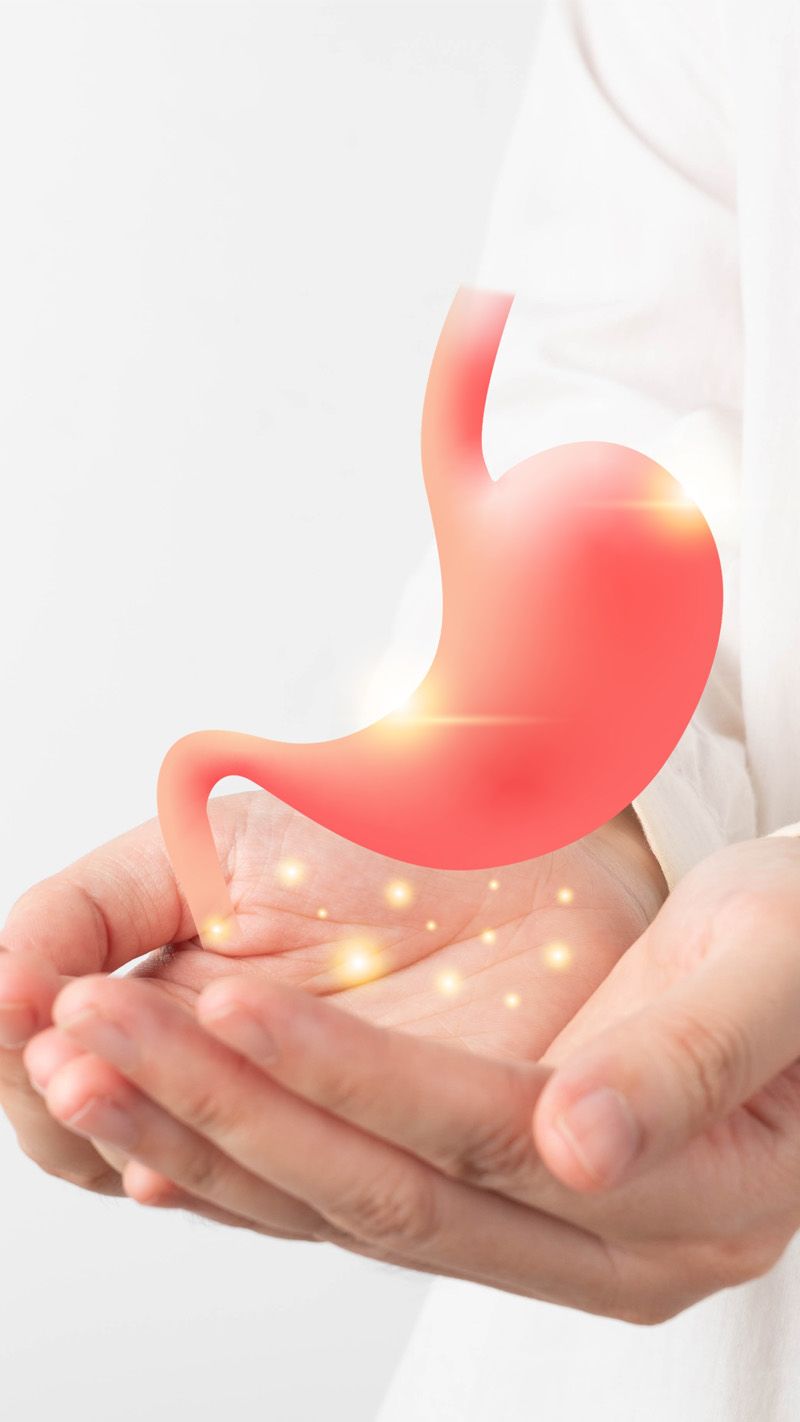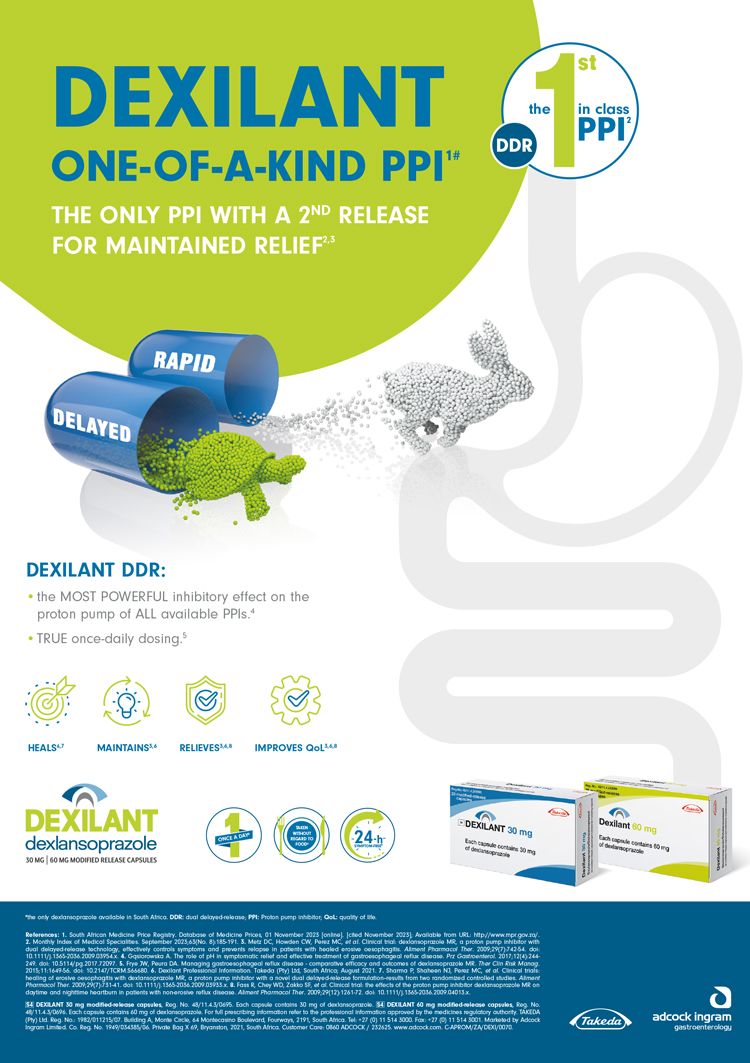The role of dexlansoprazole modified release in the management of GORD
Uncover the role of Proton Pump Inhibitors, specifically the innovative Dexlansoprazole, in managing GORD, and understand its significant impact on patients’ quality of life.

This is a CPD-accredited article. To answer a quiz about this article, click here and sign in to your Medical Academic account.

Erosive oesophagitis, caused by gastroesophageal reflux, is a common medical problem. Therapy for erosive oesophagitis primarily focuses on the pharmacological reduction of gastric acid secretion. Decreasing the acidity of gastric juice improves reflux symptoms and facilitates oesophagitis healing.2
Gastro-oesophageal reflux disease (GORD) is associated with considerable reductions in quality of life and work productivity, as well as increased healthcare use. Proton pump inhibitors (PPIs) are currently the most effective treatment for GORD. However, there are limitations associated with these drugs in terms of patients’ response.1

PROTON PUMP INHIBITORS
The PPI, introduced in 1989, targeted the gastric H+, K+-ATPase and reflected a major medical therapeutic breakthrough in the treatment of peptic ulcers and GORD, resulting in more rapid healing of the lesions and symptom relief.10 A PPI is a prodrug which is activated by acid. Activated PPI binds covalently to the gastric H+, K+ -ATPase via disulfide bond. Cys813 is the primary site responsible for the inhibition of acid pump enzyme, where PPIs bind.3
PPIs have about one hour of elimination half-life. The area under the plasmic concentration curve and the intragastric pH profile are very good indicators for evaluating PPI efficacy. Though CYP2C19 and CYP3A4 polymorphism are major components of PPI metabolism, the pharmacokinetics and pharmacodynamics of PPIs depend on the CYP2C19 genotype status.4
Omeprazole was the first PPI introduced in market, followed by pantoprazole, lansoprazole and rabeprazole. Though these PPIs share the core structures benzimidazole and pyridine, their pharmacokinetics and pharmacodynamics are a little different. Several factors must be considered in understanding the pharmacodynamics of PPIs, including:
- Accumulation of PPI in the parietal cell
- The proportion of the pump enzyme located at the canaliculus
- De novo synthesis of new pump enzyme
- Metabolism of PPI
- Amounts of covalent binding of PPI in the parietal cell
- The stability of PPI binding.4
S-omeprazole is relatively insensitive to CYP2C19, so better control of the intragastric pH is achieved. Similarly, R-lansoprazole was developed to increase the drug activity. Delayed-release formulation resulted in a longer duration of effective concentration of R-lansoprazole in blood, in addition to metabolic advantage. Dexlansoprazole showed best control of the intragastric pH among the present PPIs. Overall, PPIs made significant progress in the management of acid-related diseases and improved health-related quality of life.4
CELLULAR MECHANISM OF PROTON PUMP INHIBITORS IN THE STOMACH
In the human body, the only acidic space below pH 4 is the stomach. With the realisation that these PPIs are weak bases with a pKa between ∼4 (omeprazole, lansoprazole and pantoprazole) and 5 (rabeprazole), it was clear that they would accumulate in the acidic space of the secretory canaliculus of the stimulated parietal cell.4
This acid space dependent concentration of the PPIs is their first important property that determines their therapeutic index, giving a concentration at the luminal surface of the pump that is about 1000-fold of that in the blood. The second vital step is the low pH dependent conversion from the accumulated prodrug to the activated species that is a highly reactive cationic thiophilic reagent. This means that protonation of these compounds is required for their activation to form disulfides with cysteines of the H+, K+-ATPase.4
The presence of acid secretion is necessary for PPI action. It is recommended that they be given ∼30 minutes before a meal to ensure that the pumps are active when peak concentrations of the PPIs are present in the blood. It is also necessary to protect them from gastric acid prior to absorption.4
Because PPIs have a relatively short half-life and not all pumps are activated, it takes about three days to reach steady state inhibition of acid secretion as a balance is struck between covalent inhibition of active pump, subsequent stimulation of inactive pumps after the drug has been eliminated from the blood and de novo synthesis of new pumps.4
The target for treatment of many acid-related disorders is reduction of gastric acid secretion. Proton pump inhibitors (PPIs) are widely used to reduce acid secretion in patients with GORD.1
PPIs inhibit the secretion of hydrogen ions in the stomach by inhibiting the (H+,K+) ‑ATPase enzyme (proton pump) at the secretory surface of the gastric parietal cell, resulting in potent inhibition of gastric acid secretion with prolonged elevation of intragastric pH.3


CLINICAL LIMITATIONS
While PPIs are widely regarded as the gold-standard of GORD treatment, there are several clinical limitations to some PPIs. PPIs are associated with limited ability to fully relieve the discomfort of GORD, particularly at night. Studies show that only 23% of patients felt that their pain and discomfort was completely controlled with PPIs at night and 94% continued to experience breakthrough symptoms.
This resulted in 49% of respondents using adjunctive medications to control discomfort. In particular, 45% of respondents found that treatment for nocturnal pain was unsatisfactory. Approximately 38% of patients taking PPIs had breakthrough symptoms, and an overwhelming 65% of these patients experienced them at night.1
According to Goh et al (2016), “The active ingredient in a PPI must be present in high concentrations when the proton pumps are stimulated before and during a meal. As PPIs are acid labile, they need protection from degradation in the stomach by enteric coating or buffering. PPIs are rapidly absorbed and subsequently eliminated, leading to a short plasma half-life and ultimately restricting their administration to before meals to achieve their full effect.”1
As pre-meal dosing is not always convenient, this may lead to poor adherence. However, participants reported good adherence to the prescribed therapies in terms of frequency of administration (87%), timing of medication (87%), and mealtimes (88%).1
DEXLANSOPRAZOLE
Dexlansoprazole is the R-enantiomer of the PPI lansoprazole, a racemic mixture of R-lansoprazole and S-lansoprazole. The R-enantiomer is associated with 3-5 times greater maximum concentration (Cmax), area under the plasma concentration-time curve (AUC), and time to maximum concentration values than the S-enantiomer, and smaller total body clearance values, so it has greater systemic exposure than lansoprazole and a longer elimination half-life than S-lansoprazole.1
Dexlansoprazole is the first PPI with a dual delayed release formulation designed to provide two separate releases of medication to extend the duration of effective plasma drug concentration. Dexlansoprazole has been shown to be effective for healing of erosive oesophagitis, and to improve patient well-being by controlling 24-hour symptoms.
Dexlansoprazole has also been shown to achieve good plasma concentration, regardless of administration with or without food, providing flexible dosing.1 The dual delayed release formulation of dexlansoprazole results in a plasma concentration-time profile with two peaks.
The pharmacodynamic impact of the second peak is that PPIs work only on activated H+, K+-ATPase enzyme (proton pumps), of which 70%-80% are activated after a meal, leaving 20%-25% inactivated. These can still be activated and lead to acid secretion. Additionally, these proton pumps have a half-life of about 50 hours, meaning that approximately 25% of the pumps are produced daily at approximately 1% per hour. These newly produced H+, K+-ATPase enzyme (proton pump) can then also produce acid.

DUAL DELAYED RELEASE FORMULATION
Dexlansoprazole is a novel formulation that employs a dual delayed release technology designed to prolong the concentration-time profile and provide an extended duration of acid suppression.1
The dual delayed release technology uses two types of enteric-coated granules with different pH-dependent dissolution profiles to provide an initial drug release in the proximal small intestine, at a pH of approximately 5.5, followed several hours later by another drug release at more distal regions of the small intestine, at a pH of ≥6.75. Dexlansoprazole therefore produces a dual-peaked pharmacokinetic profile, as opposed to the single peak seen with conventional PPIs.
Dexlansoprazole increases the mean intragastric pH and the duration that intragastric pH is >4 over a 24-hour period. The optimal dose range is 30-90mg, and the two doses currently approved for clinical use are 30mg and 60mg.1
Dexlansoprazole is the first PPI with a dual delayed release formulation designed to provide two separate releases of medication. In January 2009, the FDA approved dexlansoprazole for the treatment of heartburn associated with symptomatic non-erosive GORD, healing of erosive esophagitis (EE) and maintenance of healed EE at doses of 30mg and 60mg once daily.1
24-HOUR CONTROL
The factors involved in successful treatment of GORD include acid suppression, duration of suppression over the 24-hour period, and duration of treatment. Suppression of gastric acid secretion by PPIs is at its greatest when proton pumps are the most active. It has been established that PPIs are the most effective therapy for patients with GORD. PPIs are also given in conjunction with non-steroidal anti-inflammatory drugs (NSAIDs) for patients with risk factors for upper gastrointestinal bleeding, and for acid suppression in the regimen for Helicobacter pylori eradication.1
Chiang et al (2019) compared the clinical efficacy of single doses of dexlansoprazole (modified-release 60mg) and esomeprazole (40mg) after 24-weeks follow-up in patients with mild erosive oesophagitis. Patients displaying complete symptom resolution (CSR) by the end of initial treatment (eight weeks) were switched to on-demand therapy until the end of 24 weeks.2
The GERDQ scores at 4-, 8-, 12-, 16-, 20-, and 24-week posttreatment were less than the baseline score. The CSR, rate of symptom relapse, days to symptom resolution, sustained healing rate of erosive esophagitis, treatment failure rate, and the number of tablets taken in 24 weeks were similar in both groups. The esomeprazole group had more days with reflux symptoms than the dexlansoprazole group (37.3±37.8 vs 53.9±54.2; P=0.008). In the dexlansoprazole group, patients exhibited persistent improvement in the GERDQ (a validated questionnaire) score during the on-demand period (week 8 vs week 24; P<0.001) but not in the esomeprazole group (week 8 vs week 24; P=0.846).2
This study suggests that the symptom relief effect for GERD after 24 weeks was similar for dexlansoprazole and esomeprazole. Dexlansoprazole exhibited fewer days with reflux symptoms in the 24-week study period, with better persistent improvement in the GERDQ score in the on-demand period.2
CONCLUSION
Since PPIs were introduced, considerable progress has been made in the management of acid-related diseases. The intragastric target pH can be maintained above the threshold level of >3 (peptic ulcer) or >4 (GORD) by PPIs. Specific enantiomers such as S-omeprazole and R-lansoprazole had significant advantage over the CYP2C19 enzyme. Better control of the intragastric pH was achieved by this specific enantiomer.4
Though the shape of the plasma concentration curve or the peak level was of minor importance, AUC was relatively linear fit with the antisecretory inhibition. Good linearity was observed between the amounts of PPI binding and the inhibition. Measuring the intragastric pH and AUC is enough to judge the drug efficacy. DR or ER of the drug enabled the night-time pH control due to prolonged time of effective plasma concentration.4
In patients with GORD, standard doses of esomeprazole and dexlansoprazole maintain intragastric pH above 4 for significantly longer periods compared with standard doses of other PPIs after five days of treatment. PPI treatment in GORD has been reported to result in the improvement of health-related quality of life.4

REFERENCES
- Goh KL, Choi MG, Hsu PI, Chun HJ, Mahachai V, Kachintorn U, Leelakusolvong S, Kim N, Rani AA, Wong BC, Wu J, Chiu CT, Shetty V, Bocobo JC, Chan MM, Lin JT. Pharmacological and Safety Profile of Dexlansoprazole: A New Proton Pump Inhibitor - Implications for Treatment of Gastroesophageal Reflux Disease in the Asia Pacific Region. J Neurogastroenterol Motil. 2016 Jul 30;22(3):355-66. doi: 10.5056/jnm15150. PMID: 26932927; PMCID: PMC4930293.
- Chiang HH, Wu DC, Hsu PI, Kuo CH, Tai WC, Yang SC, Wu KL, Yao CC, Tsai CE, Liang CM, Wang YK, Wang JW, Huang CF, Chuah SK; Taiwan Acid-Related Disease Study Group. Clinical efficacy of 60-mg dexlansoprazole and 40-mg esomeprazole after 24 weeks for the on-demand treatment of gastroesophageal reflux disease grades A and B: a prospective randomized trial. Drug Des Devel Ther. 2019 Apr 26;13:1347-1356. doi: 10.2147/DDDT.S193559. PMID: 31118571; PMCID: PMC6499145.
- Kukulka M, Eisenberg C, Nudurupati S. Comparator pH study to evaluate the single-dose pharmacodynamics of dual delayed-release dexlansoprazole 60 mg and delayed-release esomeprazole 40 mg. Clin Exp Gastroenterol. 2011;4:213-20. doi: 10.2147/CEG.S24063. Epub 2011 Sep 14. Erratum in: Clin Exp Gastroenterol. 2011;4:255. PMID: 22016582; PMCID: PMC3190289.
- Shin JM, Kim N. Pharmacokinetics and pharmacodynamics of the proton pump inhibitors. J Neurogastroenterol Motil. 2013 Jan;19(1):25-35. doi: 10.5056/jnm.2013.19.1.25. Epub 2013 Jan 8. PMID: 23350044; PMCID: PMC3548122.

